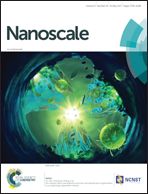Adhesion contact deformation in nanobridge tests†
Abstract
An accurate grasp of the mechanical properties, especially Young's moduli, of one dimensional nanomaterials plays a crucial role in the design and safe service of flexible electronic devices and implanted biomedical sensors. Nanobridge tests are widely used in the characterization of the mechanical properties of nanowires. In these tests, an atomic force microscope (AFM), functioning as a test machine, exerts a force to bend a nanowire suspended across a trench or a hole with the two ends fixed on a template or substrate. Adhesion contact deformation occurs inevitably during nanobridge testing between the AFM tip and the tested sample, thereby underestimating the Young's modulus of the tested nanowire and causing a pseudo-size effect in the determined Young's modulus. The present work systematically investigates the adhesion contact deformation in nanobridge tests and provides an analytical approach to evaluate the contact deformation and to determine the Young's modulus. To illustrate the developed methodology, AFM nanobridge tests were conducted on gold nanowires (180–340 nm wide, 3.6–5.1 μm long and 90 nm thick). The results indicate that when the contact deformation was taken into consideration, the average Young's modulus increased by 4.63%. Guidelines for minimizing the impact of contact deformation in practical experiments are presented. Furthermore, the results provide insight into the probable causes of the variation in experimentally obtained size-dependencies of Young's moduli of nanowires.



 Please wait while we load your content...
Please wait while we load your content...